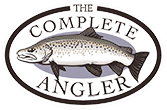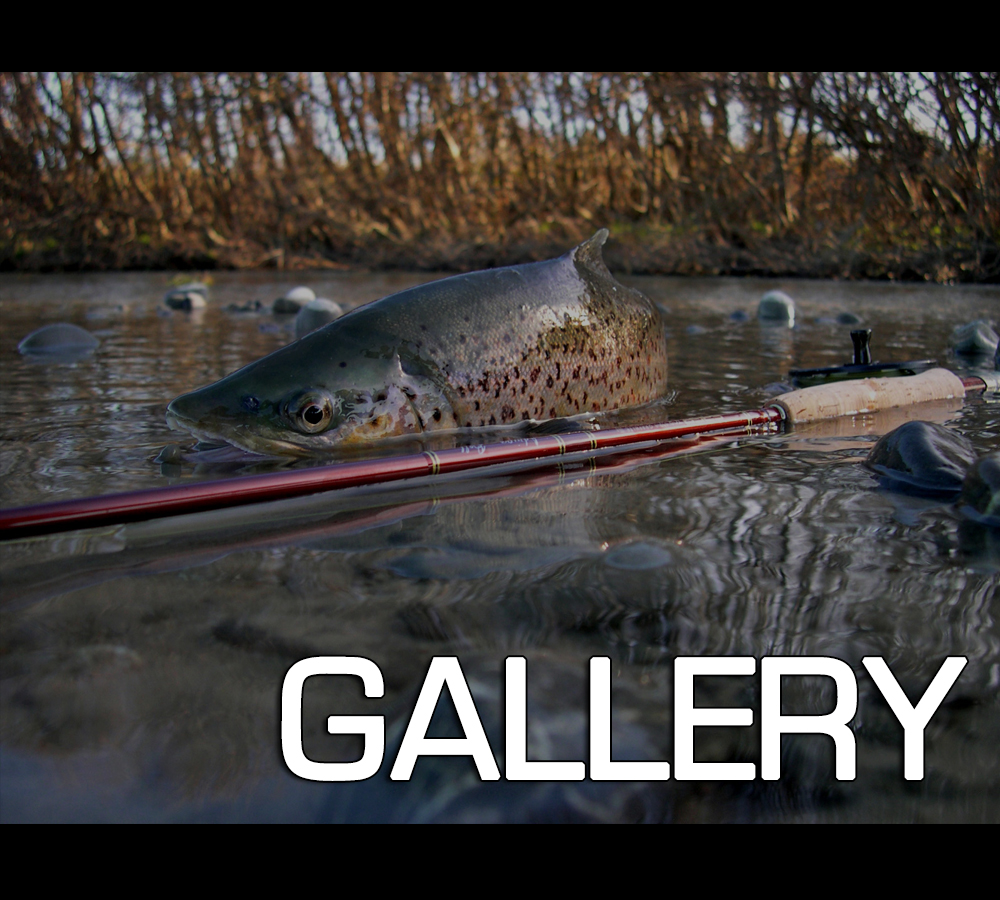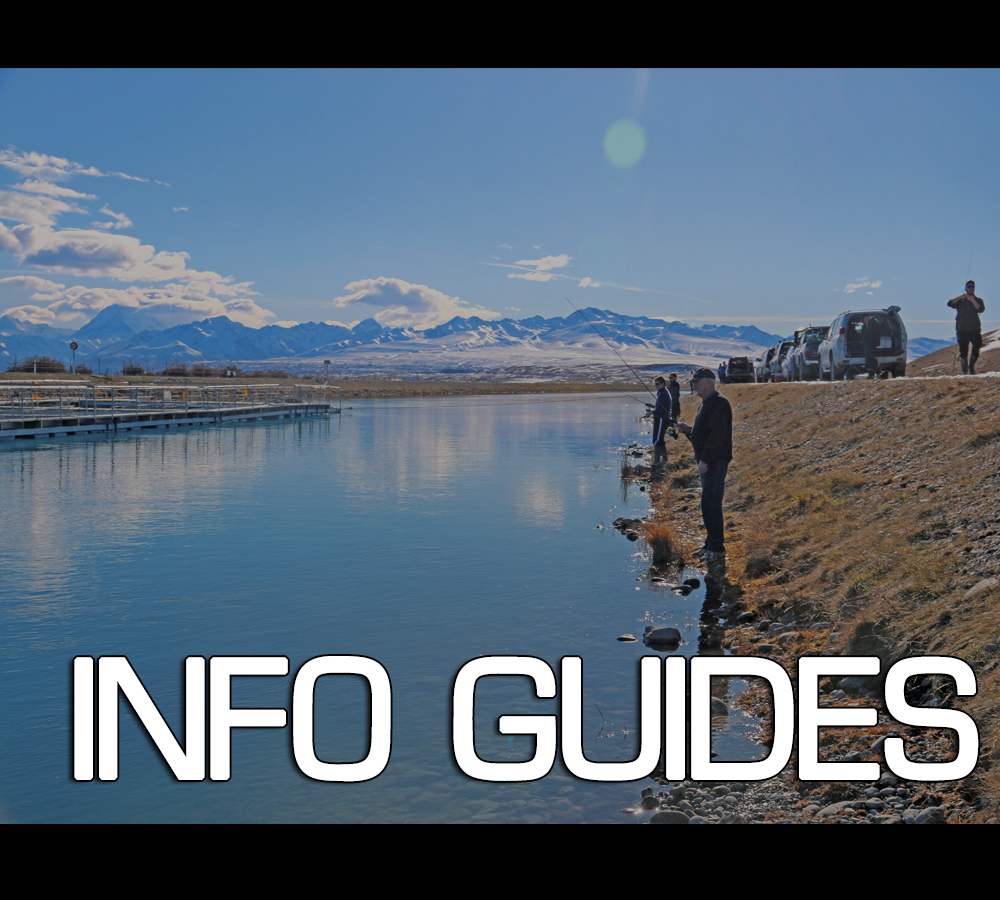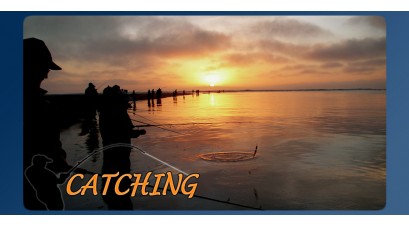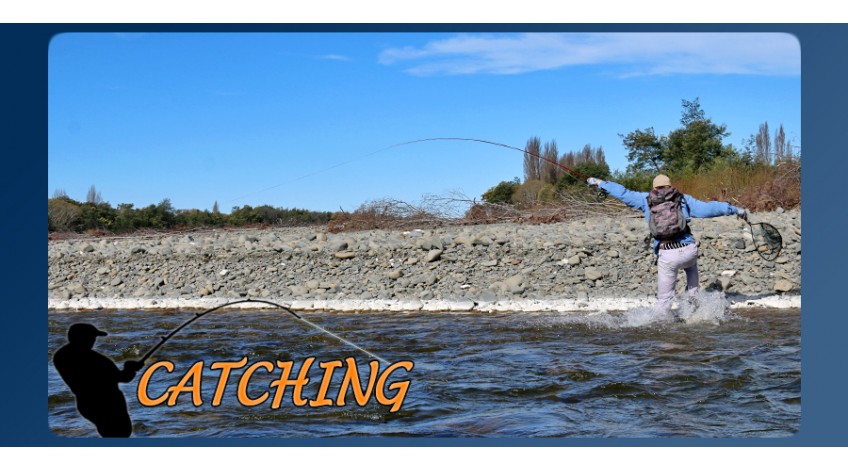

So You Want To Catch... Trout (Fly Fishing)
So You Want To Catch.. Trout (Fly Fishing)
The concept of fly fishing for trout involves casting a
feathered fly that is too light to cast with its own weight. When fly fishing,
you are actually casting the line and not the fly, which is why such a thick
line is used. Also, contrary to what you might think, the waving back and forth
of the line has nothing to do with 'fishing the fly'. Casting a fly line
involves extending the amount of line in manageable amounts (several meters at
a time) until the correct length is reached. Then the fly is settled on the
water ready for that hungry trout!
Fly Rods
Fly rods are all graded with a number ranging usually from
0-12 (although companies like Sage make specialist rods in 000 to 16). This is
the rod's 'weight'. Fly Lines are also graded with the same numbering system
and the same weight fly line should be used on a fly rod that has the same number.
For example, a 6wt fly line should be used on a 6wt fly rod.
A fly rod is designed to 'load' perfectly when a certain
amount of Fly Line is being cast (usually around 20-30 feet). When a fly rod is
pushed forward during a cast it flexes and then recovers (un-flexes if you
like) like a bow, as the angler brings the cast forward. This is what propels
the line forward and lands the fly where the angler is aiming.
A 6wt line on a 6wt rod will load the rod perfectly at around 20-30 feet. A 7wt Line (being heavier) cast on the same 6wt rod will require less line to load the rod (around 15-20 feet). In New Zealand a lot of our fishing is at close range, so some anglers purposely "over line" their rods to make short range casting easier. Unfortunately putting a lighter weight line on a rod won't usually make it cast further! Why? Because 20-30 feet is about as much line as most anglers can 'work' on a fly rod. Extra distance is achieved by 'shooting' extra line (usually stripped off the reel and lying loosely at the anglers feet) forward AFTER the rod has loaded with 20-30 feet. OK I'm getting way ahead of myself! We'll cover casting later.
Rod Quality
This is the big one! As already mentioned, in concept a fly
rod loads and unloads a little like a bow and arrow. The single most important
factor for any fly rod is it's recovery speed. This is the speed that the rod
recovers from being fully flexed to straight again (like pinging an aerial).
The faster the rod recovers, the faster the line will travel through the air on
the forward cast, generating distance, turning over the fly and cutting through
any wind the angler may be trying to cast into.
Therefore a fast recovery is GOOD! This is what you pay for
when you spend sixteen hundred hard earned dollars on a Sage, one of the top
brands on the market today. There are a whole squad of other factors that
determine how well you will cast but the big number 1 factor here is the speed
of the rod recovery. Learning to cast on a SLOW rod is like learning to race a
car in first gear!
What are the varying weights of rod used for? Generally
speaking a zero or 0wt rod is used for extremely light line, tiny streams and
tiny fish! It also casts shorter and lands very delicately on the water. A 12wt
rod is used for very heavy line, big water (usually salt water) and big
rampaging salt water beasts and Salmon! It produces big casts and turns over
big flies. Most anglers use anything from a 5 to a 7wt rod for trout fishing
with a 6wt Rod being by far the most popular and a good rod to start learning
on.
Rod Materials
Fly rods have progressed through a range of different
materials. The first rods were wood, and were pretty crude. Fly lines were
braided horse hair, not very effective either! Eventually fly rods evolved to
cane, then split cane, intricately designed casting tools. Works of art then
and now.
The rods then progressed to fibreglass and then along came
graphite (sometimes referred to as carbon fibre) and fly fishing was never the
same again. With the older slower rods the angler did all the work. The only
line speed being generated was from the anglers arm. Fast recovery graphite
blanks have changed all that. If used correctly, a fast graphite fly rod does
most of the work for you. All you have to do is apply the right technique.
Companies like Sage and Hardy are at the forefront of this
technology. They are regularly coming out with faster, lighter and easier to
use rods that continue to make fly fishing easier, more enjoyable and much more
effective. They require a decent chunk of cash up front, but the pay-offs come
back ten fold! Most also come with unconditional lifetime warranties, meaning
once you buy into the system it becomes very cost effective to stay there!
Check Out Our Fly Rod Range
Fly Lines
This is one of the most important and mis-understood areas
of fly fishing, so I want go into some detail here.
There are 3 main types of fly lines. Floating, intermediate
and sinking. Well cover this later but for now what I want to talk about is the
construction of the line. When you buy a fly line you will see the word WF or
DT written in front of it. For example if you bought a 6wt floating line you
would either see WF6F or DT6F. WF stands for 'Weight forward' and DT stands for
'Double Taper'. The F at the end (in case you hadn't already figured it out)
stands for 'Floating'!
All fly lines these days have a main body and then taper
down to a finer point that turns over and presents better.
A 'Double Taper', as it's name suggests, has a main body of
line and a taper at both ends.
A 'Weight Forward' in concept is exactly the same in the
front half as a 'Double Taper'. However 30-40 feet back the line suddenly
becomes very thin. This is called the running section.

A lot of generalizations are made about these two tapers
based on incorrect information. Most anglers will tell you that double tapers
are more delicate, give better control, roll cast better, etc. In some cases
this is true, but not always.
Delicacy and presentation is determined by the mass of the
front part of the line. A line with a small diameter tip and a long taper has
much less mass up front than a line with a thick tip and a short taper.
Therefore a DT and a WF line with the same taper and tip diameter will deliver
EXACTLY the same Almost all WF lines have a 'head' (that is the taper and the
main line before the running line) that is 35-40 feet long. Add a 12 foot
leader and the distance to the fly from the back end of the head is around 50
feet long. Up to this distance MOST DT and WF lines will cast EXACTLY the same.
What this means for most of us is that with 90% of the casts we make, there is
no difference between using a DT or a WF.
Most anglers will tell you that WF lines will cast better at
long distance than DT lines. This is true, but the difference isn't as much as
you might think. WF lines do shoot better, but only at distances from 50 feet
and upward. The key when casting WF lines is to make sure the main body of the
line is still in the tip while casting. It is impossible to cast if you get the
thin running line in the tip. The idea is that when you let the thicker line go
on the forward cast, the running line shoots through as soon as possible
causing less friction than the main line.
DT lines will still shoot too beyond this point. Just not as
well as a WF.
The BIG thing to remember here is that unless you are casting
beyond 50 feet, it is the FRONT TAPER of the line that will affect your cast
not DT versus WF. Having said that most of the lines designed with distance
tapers are WF style lines.
If you want a line that casts well at short to medium range,
make sure you have one with a SHORTER taper and a THICKER tip. More mass up
front, remember? If you want a line that presents delicately then go for a
LONGER taper and a THINNER tip.
For New Zealand conditions, especially on rivers, dealing
with wind and larger flies are the main conditions that will determine your
choice of line. Turning over the larger flies and defeating the wind means most
anglers opt for lines with more mass up front. Look on the back of the box of
most fly lines and there will be a diagram similar to the one above.
Below is a variety of WF tapers from various manufacturers:
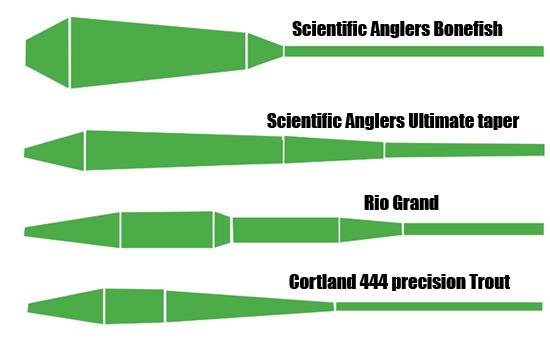
Remember these diagrams are exaggerated and compressed over
90 feet. The differences between these lines wont be quite as extreme as you
might think but they will make a difference on the water. Most of these tapers
are designed for fast action fly rods.
First off is the 'bonefish' line form Scientific Anglers.
This line is obviously designed to cast like a missile with big flies!
Brilliant for casting crab patterns 80 feet across a sand flat in Christmas
Island, but not so good for presenting a size 14 dry fly on a back country
stream!
The next line is the Scientific Anglers Ultimate taper. A
great line for turning over big dry flies and nymphs. Note however the short
front taper. The trade off for that punchy cast is going to be a reasonably
chunky presentation. In reality this line will probably present fine for 95% of
trout situations in NZ and the turn over + castability will outweigh the
slightly heavier presentation. A lot of anglers love this line!
Next up is the Rio Grand. Here we have the best of both
worlds. A medium length front taper and a heavy body that drops back to the
running line in two steps rather than a continuous taper like the SA line above
it. A good design that gives you a nice presentation, and a powerful
short/medium cast as well as a good long cast.
Last up we have the Cortland 444 precision trout. This is a
line obviously designed for powerful short to medium river work, as the rear
taper falls away quickly. Another good design for todays fast action rods,
particularly if fishing small to medium size rivers.
Floating or sinking?
Floating lines are used for 90 percent of dry fly and nymph
fishing, which accounts for most of the fishing we do here in New Zealand.
Sinking lines are used for wet lures or streamers that are
retrieved to immitate a small fish. These are mainly used on lakes, but work
equally well on larger rivers and particularly river mouths.
Most people will tell you a floating line is all you really
need to start out with. However all my first trout on a fly were caught with
sinking lines as it's a much easier technique and can be fished at night when
trout are much dumber!!
I'll talk more about floating and sinking lines later but
for now I would highly recommend both for the beginner. If you are really
pressed just get a floater but you'll miss out on some of the easier fishing
without a sinking line.
Dry Flies, Nymphs, and Wet Lures. Basic overview
Trout flies come in a staggering array of patterns and
sizes. They are sized according to the hook they are tied on. The hooks are
given a numbering system, with the bigger number referring to a smaller the
hook. For example, a size 4 hook is much bigger than a size 18. Trout flies
used in New Zealand typically range from a size 22, which is as tiny as you can
imagine and used for things like 'midge pupa' and 'willow grubs' (which would
fit on your little finger nail and still have room to move), to a size 2 which
is usually used for big wet lures and fish imitations upwards of a few inches
long. Most classic trout flies are tied
on hooks in the size 8-16 range.
Dry Flies
The classic dry fly, like it's name suggests, sits on top of
the water. It mainly represents the adult form of most aquatic larvae and bugs.
These water bugs, nymphs and larvae all rise to the surface to hatch into the
adult 'fly'. Various insects have corresponding dry fly representation. Some of
these are the classic 'Mayflies' with delicate upright wings. These drift in
the current for a few minutes before leaving the water. At this stage they
become very vulnerable to trout and trout feed heavily when a so called 'hatch'
is on. This is the classic situation where you have rising trout sucking these
insects from the surface. The dry fly is cast upstream on a floating fly line
and allowed to drift back with the current like a natural insect drifting
downstream. Trout become very 'zoned in' on the particular species of fly
hatching (presumably to save energy investigating other objects that prove to
be un-edible) and the angler generally must match the fly pattern exactly (or
at least very close) with natural fly. This is typically called 'matching the
hatch'.
Trout also feed on what are called 'terrestrial insects'
(insects that live on land and the river surrounds). Grasshoppers, cicadas,
crane flies, crickets, beetles and spiders all fall into this category.
Generally, when fish are feeding on these free falling insects they are less
selective than with 'hatching' flies. These flies are presented in the same
way. Cast upstream, and allowed to drift naturally back with the current. Fish
can still be selective with terrestrial insects but are generally not as picky
as with hatching aquatic insects.
Nymphs
Nymphs are basically the larval forms of the dry flies. They
are fished in exactly the same way in a river situation as a dry fly. They are
cast upstream usually on a floating fly line and allowed to drift back
naturally in the current, only this time beneath the surface. A sinking fly on
a floating line might not make a lot of sense right now but we'll get into that
later. Most nymphs have some weight incorporated in the body to help them sink
quickly. How do you know when a fish takes a nymph? More on this later but
usually a floating 'indicator' made from a highly buoyant material such as yarn
or foam is tied above the nymph. When a fish takes the nymph the floating
indicator will pull beneath the surface. At this stage the angler must react
quickly and set the hook.
On a lake situation nymphs are fished the same way except
crawled slowly back to the angler.
Wet Lures & Streamers
These flies are cast and retrieved on sinking lines to
imitate small fish. That pretty much sums them up! This is a very effective way
to catch trout at river mouths or fish that are holding deep in a lake. These
flies can be trolled behind a boat on deep sinking lines with a lead core to
get down to around 40 feet. This is called 'harling'.
Night time is also a great time to fish with wet lures and
streamers. Large black flies retrieved across the bottom or even retrieved on
the surface with a floating line accounts for many anglers first fish on a fly.
Leader Systems
You can't just tie the fly to the end of the fly line
right??? RIGHT!
Between the end of the fly line and the fly is the 'leader'.
This basically consists of a length of nylon anywhere from 5-18 feet long.
The leader is usually made up of two parts. The tapered
leader and the tippet.
The Tapered Leader
The tapered leader is a piece of nylon that starts off
almost as thick as the fly line and tapers down to slightly higher breaking
strain than your tippet. This is so the energy travelling down your fly line on
the forward cast progresses smoothly down to your thin tippet. If we simply
tied the tippet on to the fly line the energy suddenly jumps off the fly line
and doesn't progress down to the tippet smoothly. This creates a hinge when you
cast usually resulting in tangled tippet landing in a heap. You can still fish
like this with weighted flies but trying to turn over a dry fly into any breeze
is almost impossible. The tapered leader is usually around 6-9 feet long.
The Tippet
The tippet goes from the fine end of your tapered leader to
the fly. It is usually 5-7 feet in length.
The tippet is probably one of the most important things you
can buy. What ultimately loses more fish than anything else? Cheap or old
tippet. The tippet is the thing you place all your faith in when playing that
big rampaging brown trout, up and down the river. The introduction of fluorocarbon
(an ultra-low vis, low diameter and highly abrasion resistant material) means
that we now fish slightly heavier tippets than we used to, but there is a
limit. For most daytime trout fishing in clear conditions, 7lb is about as
heavy as most anglers like to go. The reason for this is not so much that the
trout sees the thicker tippet; it has more to do with the way thicker tippet
impairs the way a fly moves, drifts and sinks. Thick tippet holds up sinking
nymphs that will sink far quicker on lighter tippet. It doesn't allow the fly
to drift naturally and it alters the way a retrieved fly swims. Trout often
take a fly side on. The trout is far more likely to feel thicker tippet or even
push the fly out of the way with thicker, stiffer stuff!
Can the trout see your tippet? You bet they can! But only in
the right conditions. In this case it's my opinion that it's the shine or
reflection that they pick up on. This is also called 'leader flash'. If the sun
is angled right, your leader will reflect this light. It doesn't make a lot of
difference whether it's 8lb or 4lb the reflectance will be almost the same! Fluorocarbon
has reduced the 'shiny leader syndrome' a lot, but it's still a factor in some
lights.
The other issue worth noting here is the trout's lateral
line. This is the line running from the head to the tip of the tail. This picks
up every little vibration and change in water pressure in the trout's
environment. Can trout feel the presence of a leader attached to the super
tasty looking morsel they are about to eat? I don't think anyone can really
answer this, but it could be a factor. The heaviest tippets I have successfully
caught spooky daytime feeding trout on is around 8lbs. At night they'll happily
hammer a big black rabbit fly retrieved on 20lb tippet, but remember this is a
time when trout lose all their caution and feed aggressively.
I remember two fishing friends of mine spend a week fishing
together. One was using 7lb and the other using 4lb tippets. They 'hooked' the
same amount of fish. However the angler using 7lb got a lot more in the net!
These were big back country fish, where super delicate presentations of tiny
flies wasn't an issue, but it still proved a point! There are times when I have
consistently seen light tippets out fish heavy ones so the argument continues,
but as a starting point I would recommend 6lb tippet as a good place to begin.
Here is a general guideline:
Large Dry Flies (lakes & rivers) 6-7lb tippet
Large weighted Nymphs (rivers) 6-8lb tippet
Small Dry flies (lakes & rivers) 4-6lb tippet
All nymphs in lakes and small Nymphs in rivers. 4-6lb tippet
Wet lures and Streamers (day time) 6-8lb tippet
Wet lures and Streamers (night time) 8-12lb tippet
Very small sub surface emerges and midge patterns (lakes)
3-5lb tippet
Overall length of the leader system varies according to
location. For big spooky backcountry trout leaders of 18 feet or more are often
required. However a good rule of thumb for most fishing conditions is one and a
half rod lengths with a 9 foot fly rod. This gives you about 13 feet of leader.
When first learning to cast I'd recommend keeping to about 10 feet to start
with.
Fly Reels
Theres a famous saying in fly fishing circles: 'The reel is
purely there to hold the line'. What they mean by this is that with fly
fishing, the rod does all the casting and the angler should play the fish using
his hand to strip in line and release it. I say 'BOLLOCKS' to that!!!
This saying really came about from 'English chalk stream'
fishing, where a fish over a pound in weight was a monster! Sure you can just
hold the line in your hand and let the rod do the work for this kind of
fishing. What it doesn't account for is New Zealand’s big rampaging 8 pounders
stomping off down the rapid and around the corner before you can even say
something that rhymes with 'trucking bell'.
Fly reels made one massive leap forward, around the year
2000. Materials became lighter, and the width of the reel and diameter of the
spool increased dramatically to become known as 'large arbour'. Older style fly
reels (the image on the left, above) had a very deep spool that started at
about a centimetre, wide which meant two things. You had to put a lot of
backing on the reel to bulk it up and the more line you had out the harder it
became to get line back on the reel. This was because the line drop was so high
that each time you turned the handle and got one full turn on the reel you were
only getting cm's at a time.
Large Arbour reels are basically hollowed out centres with
the base of the spool being at least several inches in diameter. The reels are
bigger, but not as much as you might think because they also became wider
across to make up for the lack of depth. With this system, even if you are down
to your last few turns of backing, you still have a very high rate of retrieve.
The other down side with 'small arbour' reels is that the line is being pulled
off an ever decreasing diameter, which increased the pressure when you least
wanted it. A big trout grabs the fly, screams out towards the backing and you
could feel the increase in pressure as the diameter on the spool dropped and
the reel was having to spin faster and faster to keep up. This resulted, more
often than not, in broken tippet as the angler couldn't react in time and
loosen the drag on the reel. Large arbour reels have eliminated this problem as
well.
BUT WAIT THERE'S MORE! Remember how your line used to retain
a memory and come off in little ringlets in the last 30 meters or so? With
large arbour reels, some of the larger ones are almost as wide as the spools
the line comes on when you purchase it!
This has meant a huge reduction in 'line memory' or coiling. Add this with
todays modern 'low memory' lines and memory is almost eliminated all together.
As you can see there's a whole bunch of improvements with
this system that, when added together, make large arbour reels superior in
every way to the older small arbour reels.
Drag systems have also increased massively. Drags are a lot
smoother and longer lasting than they used to be. A lot of high end reels are
now fully waterproof having enclosed bearings and drag systems also. Now you
can finally drop your rod butt and reel in the river while changing fly or
taking the hook out of your latest catch.
Modern fly reels are works of art and an absolute pleasure
to fish with. Not only are they silky smooth, super light weight and engineered
to perfection they make a HUGE difference when you hook that 'fish of a
lifetime'! The latest models from Sage and Lamson in particular are marvels of
modern engineering, ultralight weight and produce silky smooth performance.
